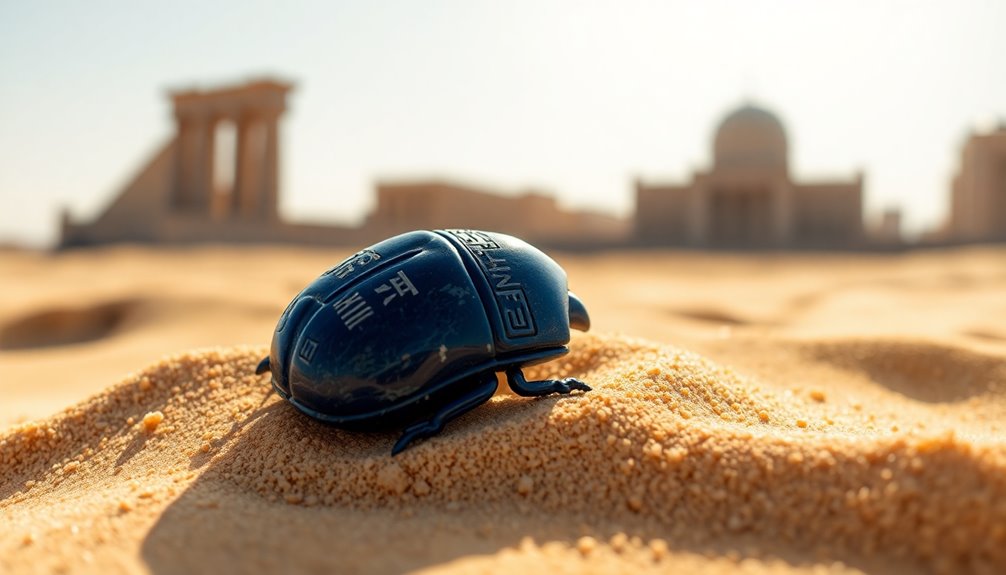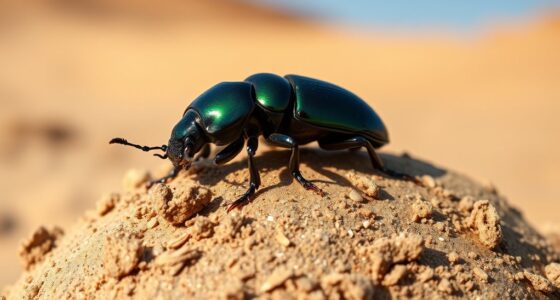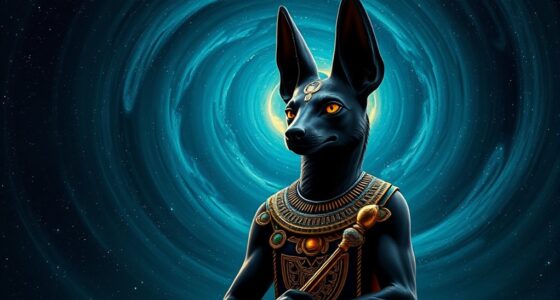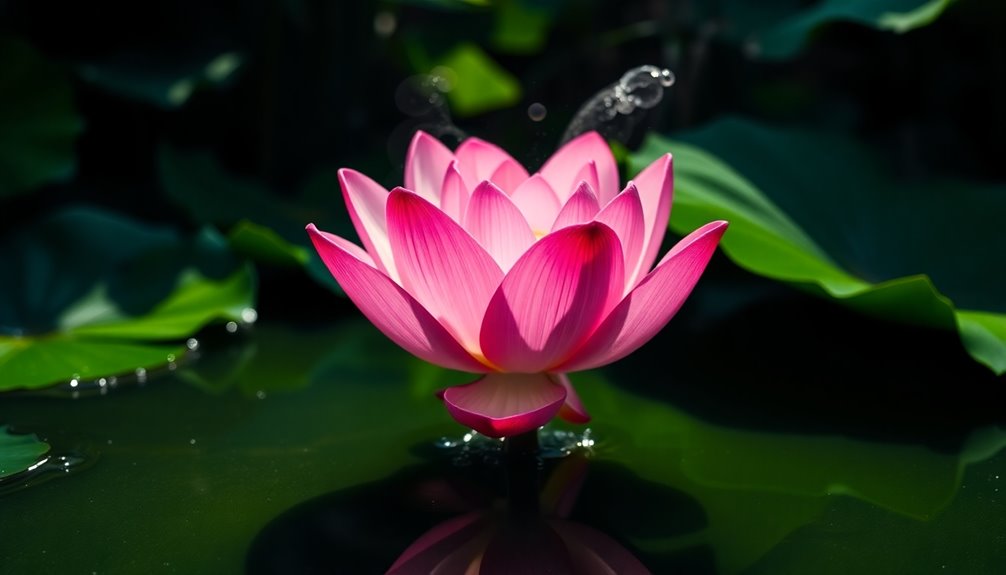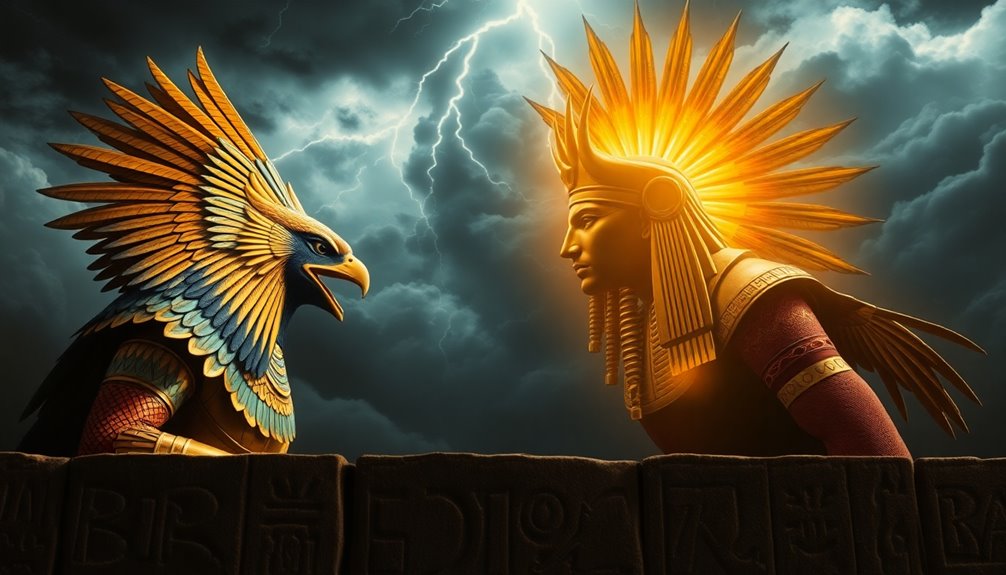Egyptian scarabs aren't just tiny artifacts; they embody powerful meanings. These symbols of resurrection and transformation have captivated people for centuries. Originating in ancient Egypt, scarabs were associated with the sun god Khepri, representing creation and rebirth. Crafted from various materials, they served both funerary and protective purposes, often placed in tombs to guide the deceased in the afterlife. Today, scarabs appear in art, jewelry, and popular culture, resonating with those seeking good fortune and protection. Their significance continues to inspire fascination, and if you explore further, you'll uncover even more layers to their rich history.
Key Takeaways
- Scarabs symbolize resurrection and transformation, deeply rooted in ancient Egyptian beliefs about the afterlife and the sun god Ra.
- Crafted from various materials, scarabs showcase exquisite artistry, making them both historical artifacts and modern decorative items.
- Used as amulets, scarabs offered protection and good fortune, resonating with people seeking positive energy in their lives today.
- Their presence in popular culture, including films and jewelry, keeps the fascination with scarabs alive and relevant.
- Scarabs serve as archaeological documents, providing insights into ancient trade networks and cultural exchanges, enriching our understanding of history.
Historical Context and Evolution
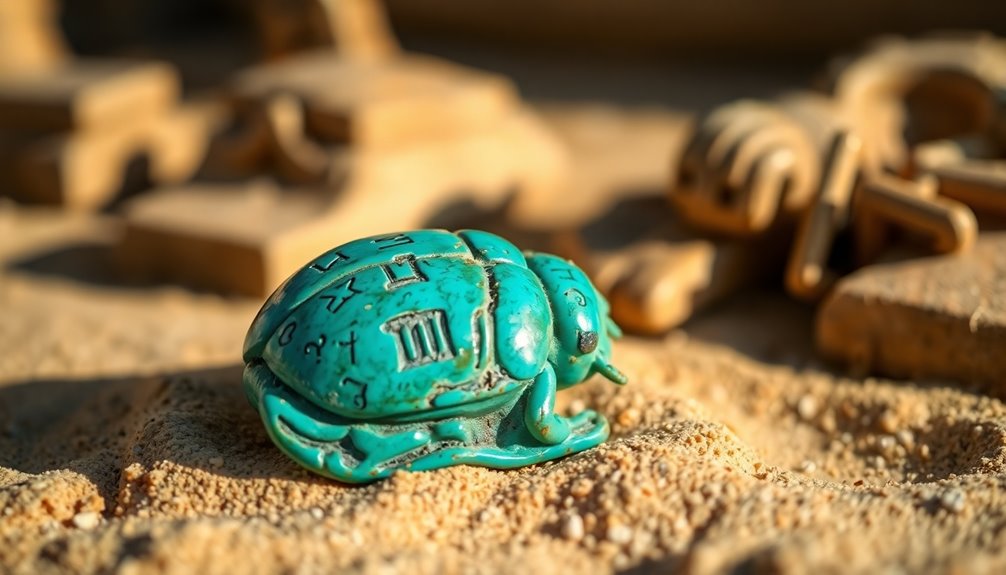
When you explore the historical context and evolution of scarabs, you uncover their fascinating journey from ancient Egypt's Early Dynastic Period around 3100–2686 BCE to their peak during the New Kingdom (c. 1550–1070 BCE).
Scarabs originated as simple amulets, but by the early Middle Kingdom, they evolved into intricate scarab seals, becoming the dominant seal form by the end of the First Intermediate Period around 2055 BCE. This shift marked a significant change in how ancient Egyptians believed in the power of these artifacts.
During the Middle Bronze Age, both imported and locally produced scarabs circulated throughout the Mediterranean and Middle East, showcasing their cultural significance and influence.
Scarab production peaked in the New Kingdom, with thousands of artifacts discovered, many inscribed with names and prayers aimed at benefiting the deceased in the afterlife.
Even into the Third Intermediate Period, scarabs retained their importance, symbolizing resurrection and transformation. This evolution reflects not just artistry but a deep-rooted belief in the scarab's protective and transformative powers, making it a cherished element of ancient Egyptian culture.
Description and Materials
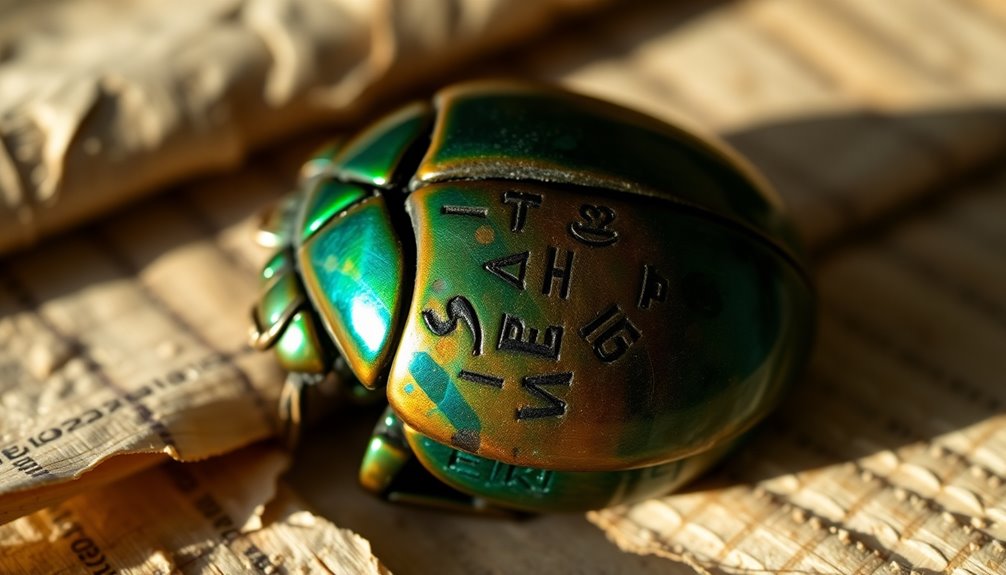
When you explore Egyptian scarabs, you'll notice they come in various types, each serving a unique purpose, from funerary to commemorative uses.
As you examine these artifacts, you'll find they're made from materials like stone, glazed faience, and hardstone variations, showcasing the skill of artisans.
Understanding these aspects gives you a clearer picture of their significance in ancient Egyptian culture.
Scarab Types Overview
Exploring the diverse world of scarabs reveals a fascinating array of types, each crafted from materials like stone and glazed faience. These tiny artifacts, inspired by scarab beetles, play a significant role in Egyptian mythology and culture. Here's an overview of the main types:
| Scarab Type | Description | Purpose |
|---|---|---|
| Funerary Scarabs | Placed in tombs with personal effects | Accompany the deceased in the afterlife |
| Heart Scarabs | Key in mummification and judgment rites | Protect the heart during the afterlife |
| Pectoral Scarabs | Larger, often uninscribed, sewn onto mummies | Symbolize protection from Khepri |
| Commemorative Scarabs | Commissioned by pharaohs, celebrate events | Honor significant milestones |
Naturalistic scarabs feature detailed carvings, showcasing the artistry of ancient Egypt. Their sizes generally range from 6 mm to 40 mm, with common sizes between 10 mm and 20 mm. Each type serves distinct purposes, reflecting the rich tapestry of beliefs and practices surrounding these potent symbols in Egyptian mythology.
Materials Used in Scarabs
Scarab production showcases a remarkable variety of materials that reflect their cultural significance in ancient Egypt. You'll find that scarabs were primarily crafted from stone, glazed blue or green Egyptian faience, and hardstones like green jasper, amethyst, and carnelian. Each material not only highlights the artisanship involved but also the deep-rooted beliefs tied to the scarab beetle as a symbol of rebirth and protection.
Naturalistic scarabs, known for their intricate carvings, were often made from diverse materials, showcasing the skill of ancient craftsmen. Jewelry scarabs evolved into rings with bezels, typically crafted from glazed steatite, merging practicality with ornamental appeal.
When it comes to size, most scarabs measured between 10 mm and 20 mm, indicating careful design consideration. Commemorative scarabs, commissioned by pharaohs, were larger—ranging from 3.5 cm to 10 cm—to celebrate significant events.
This thoughtful use of materials used in scarabs not only served aesthetic purposes but also reinforced their roles in both personal and political contexts, making them cherished artifacts that continue to fascinate us today.
Types of Scarabs

Throughout ancient Egyptian history, various types of scarabs were crafted, each serving a distinct purpose and carrying unique symbolism. Funerary scarabs were commonly placed in tombs alongside personal effects or jewelry to aid the deceased in their afterlife journey. These scarabs offered protection during their passage to the afterlife, reflecting the deep beliefs within Egyptian art and culture.
Heart scarabs played an essential role in mummification and judgment rites. They were believed to safeguard the heart during the weighing of the soul, a significant moment in the afterlife journey.
Pectoral scarabs, typically larger and flat, were often uninscribed and associated with the sun god Khepri. These were sewn onto mummies as protective amulets.
Naturalistic scarabs showcased intricate artistry, carved from various materials, highlighting the cultural significance of the beetle in Egyptian society.
Finally, commemorative scarabs, ranging from 3.5 cm to 10 cm, were commissioned by pharaohs to celebrate significant events, often featuring unique inscriptions that marked their historical importance.
Each type of scarab not only served a practical function but also embodied the rich symbolism embedded in Egyptian art.
Religious Significance

The various types of scarabs crafted in ancient Egypt not only served practical purposes but also held profound religious significance. These tiny artifacts symbolize resurrection and transformation, deeply intertwined with the worship of the sun god Ra and Khepri, who represents the morning sun's emergence.
Scarabs were often depicted in art holding the sun ball, emphasizing their role as a solar symbol and a representation of the eternal cycle of life.
Heart scarabs played an essential role in mummification rituals, inscribed with spells from the Book of the Dead to protect the deceased during their judgment in the afterlife. Funerary scarabs were placed in tombs alongside personal items, acting as amulets for protection and good fortune on the journey to the afterlife.
The intricate designs and inscriptions on scarabs served not only as personal identification but also conveyed significant religious messages and beliefs about life after death.
In this way, scarabs were more than mere artifacts; they embodied the Egyptians' spiritual beliefs and their hope for immortality, making them a fundamental part of ancient Egyptian religion.
Cultural Importance

While many people associate scarabs primarily with religious practices, their cultural importance in ancient Egypt extends far beyond that. Scarabs embody concepts of resurrection, transformation, and the eternal cycle of life, closely linked to the sun god Ra and the deity Khepri, who symbolizes the morning sun. These small artifacts served as powerful reminders of life's continuity and the connection between the earthly and the divine.
Funerary scarabs were often placed in tombs alongside personal belongings or jewelry, acting as protective amulets for the deceased's journey into the afterlife. Heart scarabs played a crucial role in mummification, inscribed with spells from the Book of the Dead to safeguard the deceased during judgment. This reflects the deep-rooted belief in the afterlife and the importance of protection in that domain.
Beyond their funerary roles, scarabs featured prominently in jewelry and art, symbolizing protection and good fortune. Their widespread use, including imitations crafted by Canaanite artisans, points to a rich tapestry of cultural exchanges and trade networks, demonstrating how scarabs transcended their religious significance to become essential cultural icons in ancient Egypt.
Scarabs in Trade
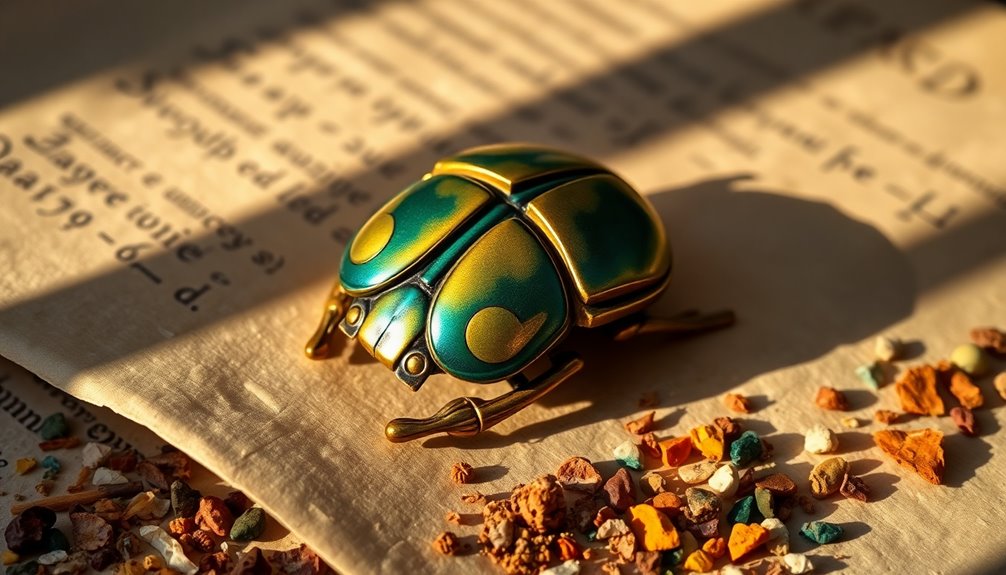
Scarabs played a significant role in trade networks during the Bronze Age, connecting Egypt with neighboring regions. These small artifacts weren't just decorative; they bore unique inscriptions that helped trace historical trade routes and relationships.
Canaanite artisans even crafted imitations of Egyptian scarabs, introducing new designs that reflected the cultural exchanges between their civilizations. The presence of scarabs in foreign burial sites, like those found in Punic grounds, highlights the spread of Egyptian influence.
Cultures such as the Phoenicians adopted scarab designs during the Achaemenid Empire, showcasing how deeply interconnected these societies became through trade. Scarabs served multiple purposes—they were used for personal identification, as amulets, and even as diplomatic messages.
Some notable examples include a gold scarab linked to Queen Nefertiti, discovered in shipwrecks, which provides historical evidence of Egyptian trade and diplomacy. The trade of scarabs involved various materials, with exquisite pieces made from semi-precious stones, reflecting a demand for luxurious goods.
This demand facilitated not only cultural exchanges but also economic interactions across the Mediterranean, further solidifying the importance of scarabs in ancient trade.
Modern Popularity
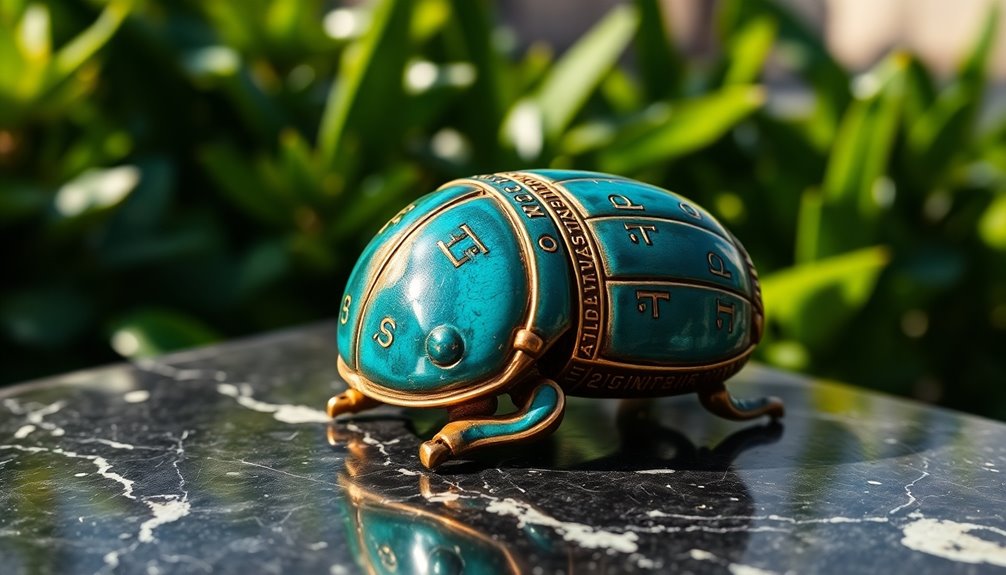
In recent years, the scarab has surged in popularity, enchanting modern culture across various mediums. Egyptian Scarabs have become iconic symbols, especially in films like "The Mummy," where they're portrayed as both dangerous and mystical, adding an exciting layer to their historical significance.
Music lovers also connect with this artifact, as the band Journey uses scarab imagery in their logos to convey themes of transformation and rebirth.
In the gaming world, franchises like "Tomb Raider" and "Dungeons and Dragons" have embraced scarabs as motifs that represent ancient mysteries, intriguing players with their allure.
Beyond entertainment, these ancient symbols have made their way into jewelry and fashion, celebrated for their meanings of protection and good fortune, aligning with their storied past in ancient Egypt.
You'll also find Egyptian Scarabs in home decor and art, reflecting a growing interest in ancient Egyptian culture and aesthetics.
This modern popularity highlights a collective fascination with the scarab's symbolism of resurrection and eternal life, making it a versatile motif that resonates deeply across various aspects of contemporary life.
Artistic Representations

Often found in ancient Egyptian art, scarabs symbolize profound themes of creation and rebirth. These tiny artifacts are frequently depicted holding the sun ball in their front legs, emphasizing their connection to the sun god Khepri. This connection represents the cycle of life and regeneration.
Significantly, about 75% of artistic representations of scarabs feature them alongside water lilies, hinting at a deeper symbolic relationship within Egyptian mythology.
The craftsmanship involved in creating scarabs showcases the meticulous skill of ancient artisans. Their detailed carvings reveal intricate anatomical features and designs, highlighting the cultural significance of these artifacts.
Scarabs weren't just decorative; they served as personal seals and protective symbols in jewelry and amulets, believed to bring good fortune to their wearers.
As time progressed, the evolution of scarab seals shifted from simple designs to more complex forms, reflecting their growing importance in society. They became tools for personal identification and political propaganda, further cementing their status in ancient Egyptian culture.
Through these artistic representations, the scarab remains a powerful emblem of life, protection, and identity.
Archaeological Insights

The intricate craftsmanship of scarabs not only showcases the artistry of ancient Egyptians but also serves as a window into their historical narratives. As you explore these fascinating artifacts, you'll discover that scarabs evolved from simple stamp designs to complex forms, becoming the dominant seal type in ancient Egypt. They played a crucial role in both royal jewelry and everyday life.
Here are some key archaeological insights about scarabs:
- Scarabs act as archaeological documents, aiding in dating historical timelines.
- Design elements can help pinpoint specific reigns and periods.
- Heart scarabs, placed on mummies, symbolize the deceased's judgment in the afterlife.
- Findings of scarabs abroad suggest extensive trade networks with Egypt.
- A gold scarab linked to Queen Nefertiti highlights diplomatic connections.
These small artifacts often carry royal names, serving as personal identification tools similar to modern signet rings.
Scarabs found in burial contexts or shipwrecks provide evidence of political messaging in ancient times, revealing much about Egyptian society and its interactions.
Delving into scarabs can deepen your understanding of Egypt's rich history and the connections it forged across the Mediterranean.
Frequently Asked Questions
What Does Egyptian Scarab Symbolize?
The Egyptian scarab symbolizes resurrection and transformation, connecting you to the eternal cycles of life and renewal.
Associated with the sun god Ra and the deity Khepri, it embodies the spirit of rebirth.
When you see a scarab, think of its role as an amulet for protection and good fortune, especially in funerary practices.
It's not just an artifact; it represents a deep spiritual significance in ancient Egyptian culture.
What Is the Metaphor of the Scarab?
The scarab serves as a powerful metaphor for resurrection and transformation. It symbolizes the eternal cycle of life and the journey through the afterlife.
When you think of scarabs, you might envision protection and good luck, as they're often used as amulets. They remind you of moral integrity and the importance of safeguarding one's spirit.
This tiny artifact connects the past and the present, embodying profound cultural and spiritual significance.
Do Scarabs Go Under Your Skin?
No, scarabs don't go under your skin. These tiny beetles, particularly Scarabaeus sacer, are ground-dwellers known for rolling dung, not burrowing into flesh.
The idea that they could penetrate skin is a misconception, often stemming from myths. In reality, their size, typically between 6 mm and 40 mm, makes them too small to pose any threat.
Instead, they play an important ecological role by decomposing waste, contributing to a healthier environment.
What Is the Meaning of the Scarab Pendant?
The scarab pendant symbolizes resurrection and protection. When you wear one, you're connecting to its ancient significance, which includes safeguarding your spirit and invoking blessings for a positive journey in life.
Often adorned with inscriptions, these pendants reflect themes of creation and the cyclical nature of existence. By choosing a scarab pendant, you're not just wearing jewelry; you're embracing a powerful emblem of good luck and spiritual heritage.
Conclusion
In a world where digital symbols dominate, the ancient scarab reminds us of our deep-rooted connection to history and spirituality. While today's trends come and go, the timeless allure of this tiny artifact endures, bridging past and present. You might find it fascinating how a small piece of art can carry such profound meaning, serving as both a talisman of protection and a reminder of life's cyclical nature. Embrace the magic of the scarab; it's more than just an ornament.

